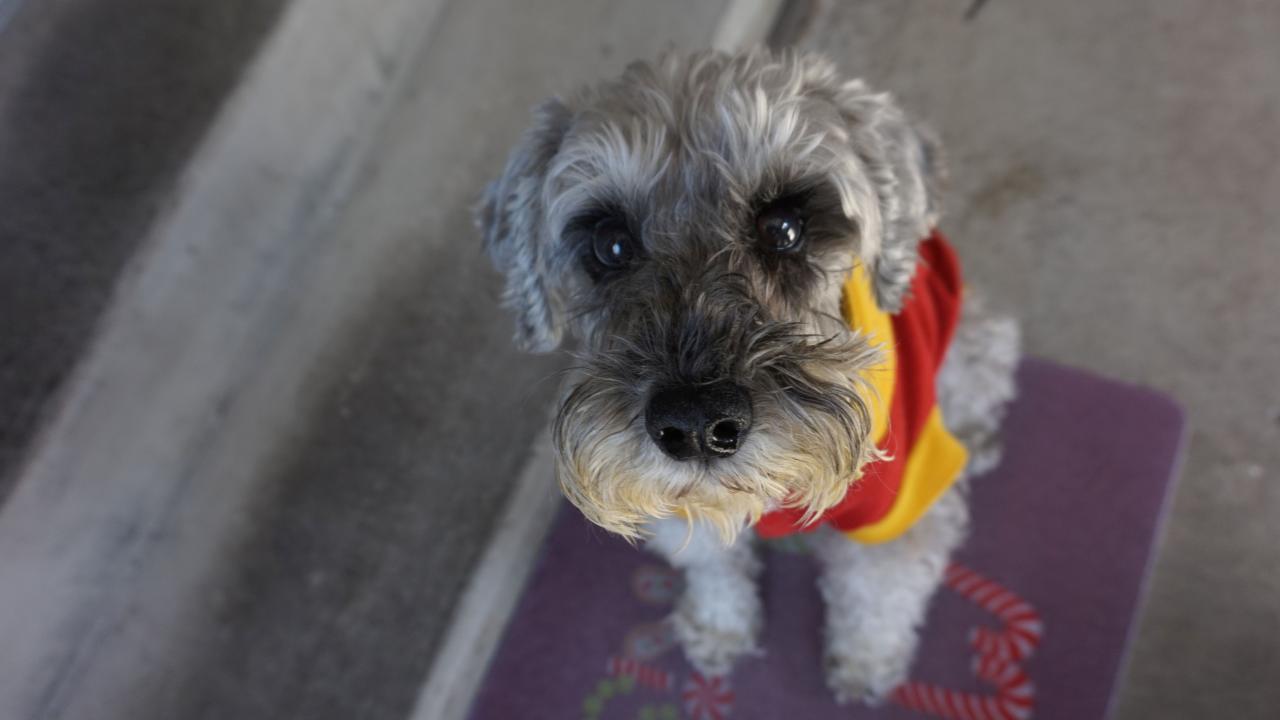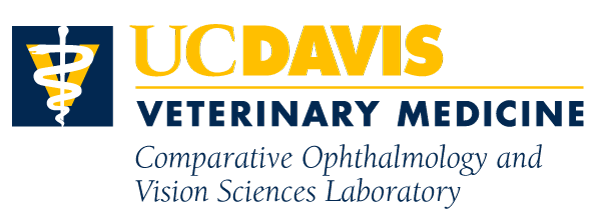
COLLABORATIVE EFFORT HELPS DOG SEE AGAIN
“Case of the Month” – June 2019
Bobby, a 12-year-old male miniature Schnauzer, developed cataracts in both eyes, presumably brought on by his diabetes. While he could still sense light in his eyes, the cataracts clouded his vision to the point of essential blindness. Navigation of his home was accomplished by memory and by utilizing a heightened sense of feel, especially on the staircase. His owner, John Yeung, was eager to have Bobby’s vision restored, so he sought out the help of UC Davis alum and former ophthalmology resident Dr. Kristina Burling, a board-certified ophthalmologist. Since 1994, Dr. Burling has owned and operated Animal Eye Specialists in Campbell, California near Yeung’s home in San Jose.
Dr. Burling successfully performed cataract surgery on Bobby’s left eye. However, the cataract removal on his right eye had to be abruptly stopped mid-surgery due to an underlying systemic disease that caused Bobby’s heartrate to fall dangerously low. Dr. Burling made the smart decision to stop the surgery, as Bobby was no longer in a healthy enough position to proceed.
She sought out the assistance of other ophthalmologists regarding timing of a potential continuation of the surgery, as opening the lens of the eye without fully removing it can cause permanent problems if not completed in a timely manner. The general consensus was that Bobby’s surgery needed to be completed within 3-4 days if it was to be successful. Burling immediately recommended that Bobby’s ophthalmic care be continued at a hospital that could perform the surgery while simultaneously attending to his cardiac and anesthetic needs with board-certified specialists in those disciplines.
Quickly, Dr. Brian Leonard, a board-certified ophthalmologist with the Ophthalmology Service, notified Burling that he could lead an immediate effort with his colleagues at UC Davis – the only place in California that had the three specialties under one roof.
Dr. Leonard consulted with his board-certified colleagues in the Cardiology Service and the Anesthesia/Critical Patient Care Service. A large team of specialists, technicians, and students was assembled, and together they developed a plan to proceed with surgery on Bobby’s right eye. Anesthesiologists Drs. Robert Brosnan and Harriet Flynn, along with cardiologist Dr. Josh Stern would monitor his critical condition and cardiac function with an electrocardiogram, Doppler ultrasound imaging, and an external pacemaker, if necessary. Atropine—a medication to treat slow heartrate during surgery—would be ready for use should episodes of Bobby’s heart condition occur again.
“Dr. Leonard was confident about performing the surgery because he didn’t need to worry about the other issues,” said Yeung. “He could concentrate on the eye while the other specialists could take care of Bobby’s anesthetic needs and his heart problems.”
Thanks to the collaborative effort, the surgery was a success. Bobby’s heart conditions while under anesthesia did not return during the second surgery, and he recovered without incident.
“Our cardiologists and anesthesiologists did a phenomenal job with this case,” said Dr. Leonard. “I want to commend their efforts and teamwork. We are not able to perform our extensive amount of surgeries per year without their expertise.”
The UC Davis veterinary hospital has the largest anesthesiology team of any hospital in California, currently with eight faculty members and four residents. They successfully anesthetize the most high-risk patients without complications, which allows faculty and resident surgeons to perform thousands of procedures every year. Their ability to properly anesthetize dozens of different species of animals—from some that weigh less than a pound to those that weigh nearly a ton—is a testament to their training and continued dedication to their craft. To achieve Diplomate (board-certified) status in the American College of Veterinary Anesthesia and Analgesia (ACVAA), veterinarians must complete four years of specialized training in internships and residencies beyond veterinary school, as well as pass arduous examinations. There are less than 230 Diplomates of the ACVAA practicing around the world.
Following surgery, Yeung noticed extra energy in Bobby’s stride as they left the hospital.
“He was just so happy to be seeing again,” said Yeung. “He seemed so light on his feet – he was kicking them up with excitement.”
Yeung reports that Bobby has been getting around the house well and hasn’t missed any stairs.
To see more photos of Bobby – Click here
The School of Veterinary Medicine’s efforts to build a new Veterinary Medical Center are underway. A larger hospital will allow the school to provide clinical experience for veterinary students and veterinary specialists in a more efficient and effective manner. More life-changing surgeries like Bobby’s will be possible with an increased caseload, more advanced equipment and surgical suites, and clinical trials research translating to cutting-edge care. Please consider joining us on that journey.
